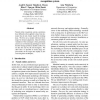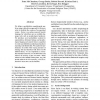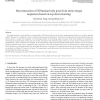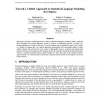122
click to vote
INTERSPEECH
2010
14 years 7 months ago
2010
In this work, the RWTH automatic speech recognition systems for English and German for the second Quaero evaluation campaign 2009 are presented. The systems are designed to transc...
106
Voted
COLING
2010
14 years 7 months ago
2010
Polarity shifting marked by various linguistic structures has been a challenge to automatic sentiment classification. In this paper, we propose a machine learning approach to inco...
106
click to vote
ACL
2009
14 years 10 months ago
2009
Letter-to-phoneme (L2P) conversion is the process of producing a correct phoneme sequence for a word, given its letters. It is often desirable to reduce the quantity of training d...
105
Voted
NAACL
2010
14 years 10 months ago
2010
Named entity recognition systems sometimes have difficulty when applied to data from domains that do not closely match the training data. We first use a simple rule-based techniqu...
ICPR
2010
IEEE
14 years 10 months ago
2010
IEEE
In this paper, we propose a tree-structured multiclass classifier to identify annotations and overlapping text from machine printed documents. Each node of the tree-structured cla...
107
Voted
ICPR
2010
IEEE
14 years 10 months ago
2010
IEEE
In this paper we redefine and generalize the classic k-nearest neighbors (k-NN) voting rule in a Bayesian maximum-a-posteriori (MAP) framework. Therefore, annotated examples are u...
104
Voted
EMNLP
2010
14 years 10 months ago
2010
We define a probabilistic morphological analyzer using a data-driven approach for Syriac in order to facilitate the creation of an annotated corpus. Syriac is an under-resourced S...
133
click to vote
PR
2007
15 years 1 days ago
2007
This paper presents a novel method for reconstructing a 3D human body pose from stereo image sequences based on a top-down learning method. However, it is inefficient to build a ...
TALIP
2002
15 years 5 days ago
2002
This paper presents a unified approach to Chinese statistical language modeling (SLM). Applying SLM techniques like trigram language models to Chinese is challenging because (1) t...
121
click to vote
SIGIR
2008
ACM
15 years 14 days ago
2008
ACM
This work presents the use of click graphs in improving query intent classifiers, which are critical if vertical search and general-purpose search services are to be offered in a ...




